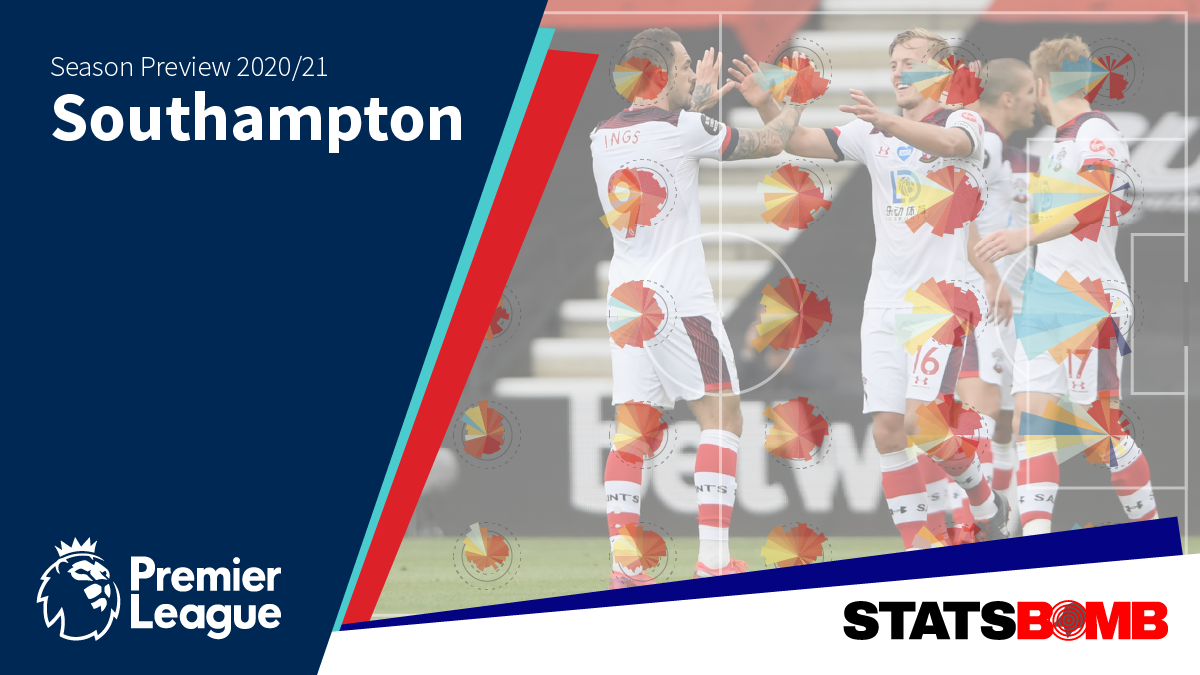During the opening few weeks of 2019-20, Ralph Hasenhüttl mixed up his formations a little. The well-remembered Leicester game was the sixth time in ten matches that Southampton started with a variation involving three centre backs. That game wasn’t the final straw--two more games took place before an international break, but when Southampton came back to face Arsenal on the 23rd November, they played a version of 4-4-2. And from that point on they stuck to it. The reason for this change was clear enough: Southampton were 19th and on a run of no wins in seven. If ever there’s a good time to refocus thoughts, then languishing in the relegation places with your job under threat is it and Hasenhüttl quickly went back to basics. From that point on, Southampton pressed more frequently (led the league in volume of pressure events), timed their pressure events more aptly (led the league for counterpressure events), were more aggressive in closing down opponent pass receipts than any other team (29%) and had the lowest pass per defensive action value. Results improved and quickly: a 2-2-8 start gave way to a 8-2-7 run pre-Covid break and 5-3-1 afterwards. Metrics generally followed suit too with a -0.4xG difference per 90 in that weak period switching round to +0.18 for the rest of the season (albeit the post-Covid metrics lagged behind good results). However you slice it though, once Hasenhüttl went to his pressing 4-4-2, Southampton were pretty good, around the sixth or seventh best team in the league. 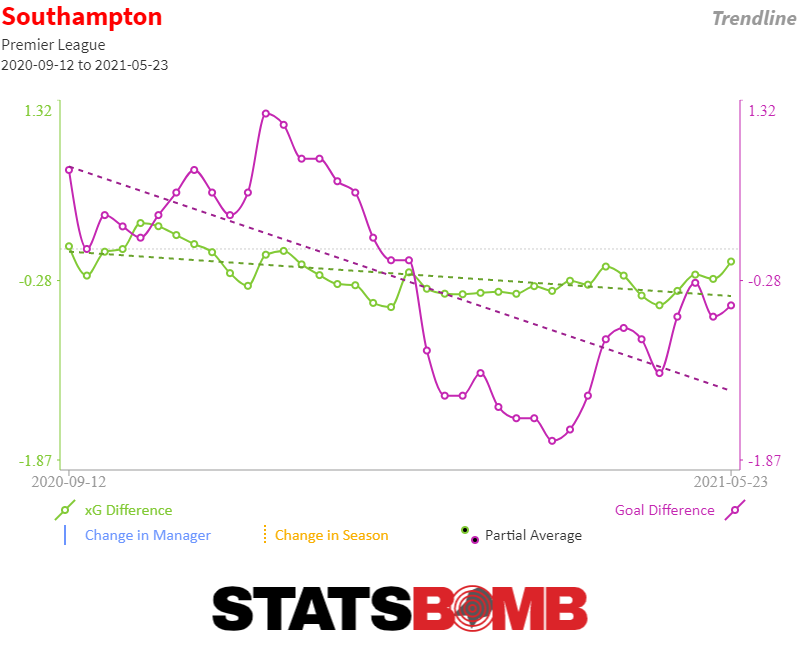 There were bad games across the season, and that rather impacted the metrics as a whole. Seven times Southampton gave up large xG totals (around 2.5 and up) in individual games. Some of them were understandable; both Manchester City games, Liverpool away and the 9-0, but it also occurred in back to back games just before the Covid break away to West Ham and home to Newcastle (thanks to Moussa Djenepo's first half red card) and then at home to Arsenal after the restart:
There were bad games across the season, and that rather impacted the metrics as a whole. Seven times Southampton gave up large xG totals (around 2.5 and up) in individual games. Some of them were understandable; both Manchester City games, Liverpool away and the 9-0, but it also occurred in back to back games just before the Covid break away to West Ham and home to Newcastle (thanks to Moussa Djenepo's first half red card) and then at home to Arsenal after the restart: 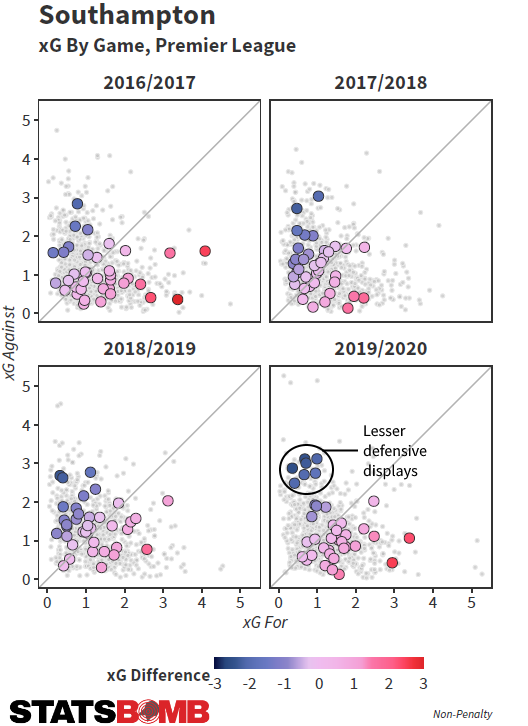 There's little doubt that this kind of vulnerability can be a by-product of games in which pressing teams are outmaneuvered. The Liverpool away game is a great example, as the team competed really well in the first half but Liverpool exerted themselves as the game wore on and won 4-0. The passing network from that game shows the generally equal balance of the game in regard to possession locations, which is unusual for a team against Liverpool. Another real rarity was Trent Alexander-Arnold getting pushed right back into the er... right back slot:
There's little doubt that this kind of vulnerability can be a by-product of games in which pressing teams are outmaneuvered. The Liverpool away game is a great example, as the team competed really well in the first half but Liverpool exerted themselves as the game wore on and won 4-0. The passing network from that game shows the generally equal balance of the game in regard to possession locations, which is unusual for a team against Liverpool. Another real rarity was Trent Alexander-Arnold getting pushed right back into the er... right back slot: 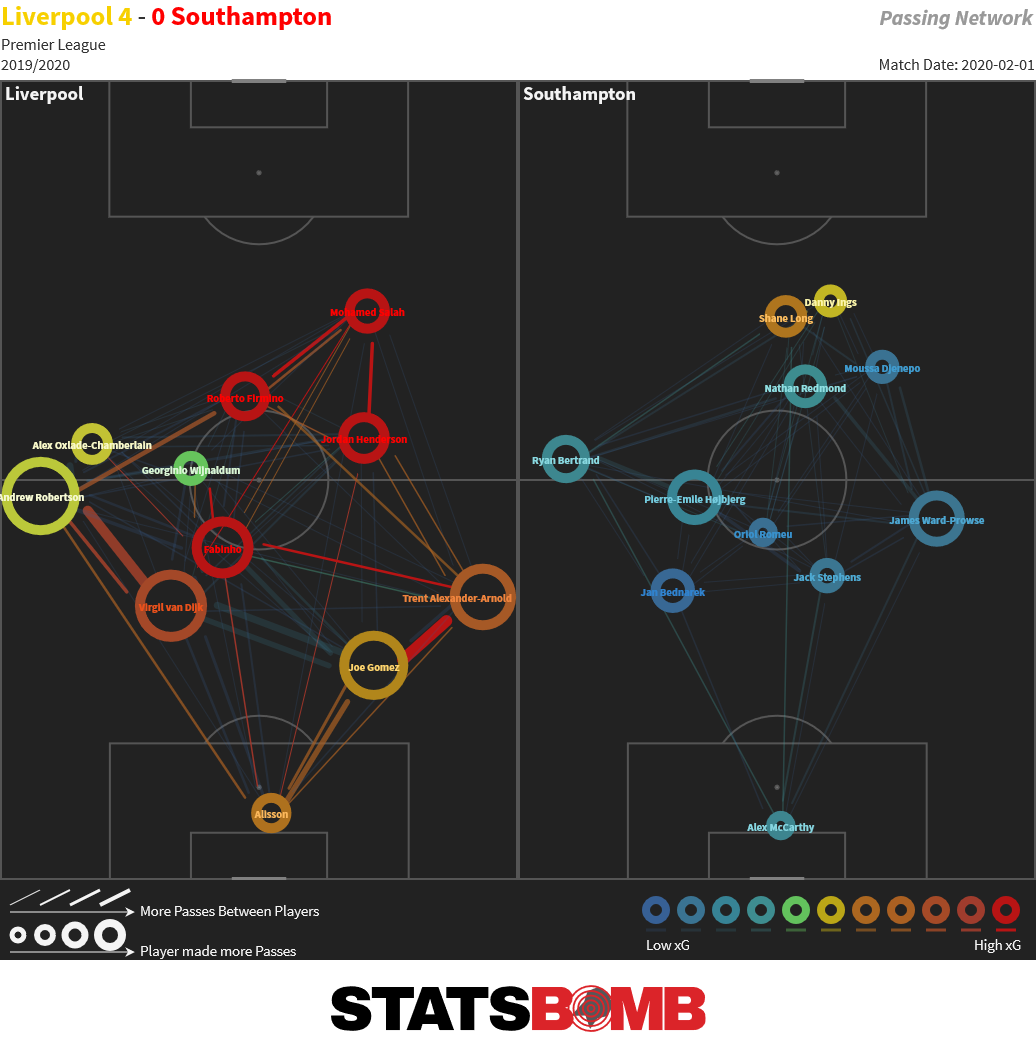 Southampton’s season was gilded by a phenomenal season from Danny Ings. He scored 22 goals in the league (21+1 penalty) from an expected rate of close to 16, but more remarkable was his sheer consistency. Across the past four seasons, only Mohamed Salah in 2017-18 has scored a non-penalty goal in over half a team’s games in a season (23 separate games), Ings is second on that list having notched in 19. If you sat down to watch a Southampton game in 2019-20 it was a literal coin flip whether or not you’d see an Ings goal. He only scored one header and was not adept at getting on the end of crosses from open play, but otherwise scored a likeable variation of goals: tap-ins, off throughballs, after beating a defender to make space or a shot, from longer range and with both feet.
Southampton’s season was gilded by a phenomenal season from Danny Ings. He scored 22 goals in the league (21+1 penalty) from an expected rate of close to 16, but more remarkable was his sheer consistency. Across the past four seasons, only Mohamed Salah in 2017-18 has scored a non-penalty goal in over half a team’s games in a season (23 separate games), Ings is second on that list having notched in 19. If you sat down to watch a Southampton game in 2019-20 it was a literal coin flip whether or not you’d see an Ings goal. He only scored one header and was not adept at getting on the end of crosses from open play, but otherwise scored a likeable variation of goals: tap-ins, off throughballs, after beating a defender to make space or a shot, from longer range and with both feet. 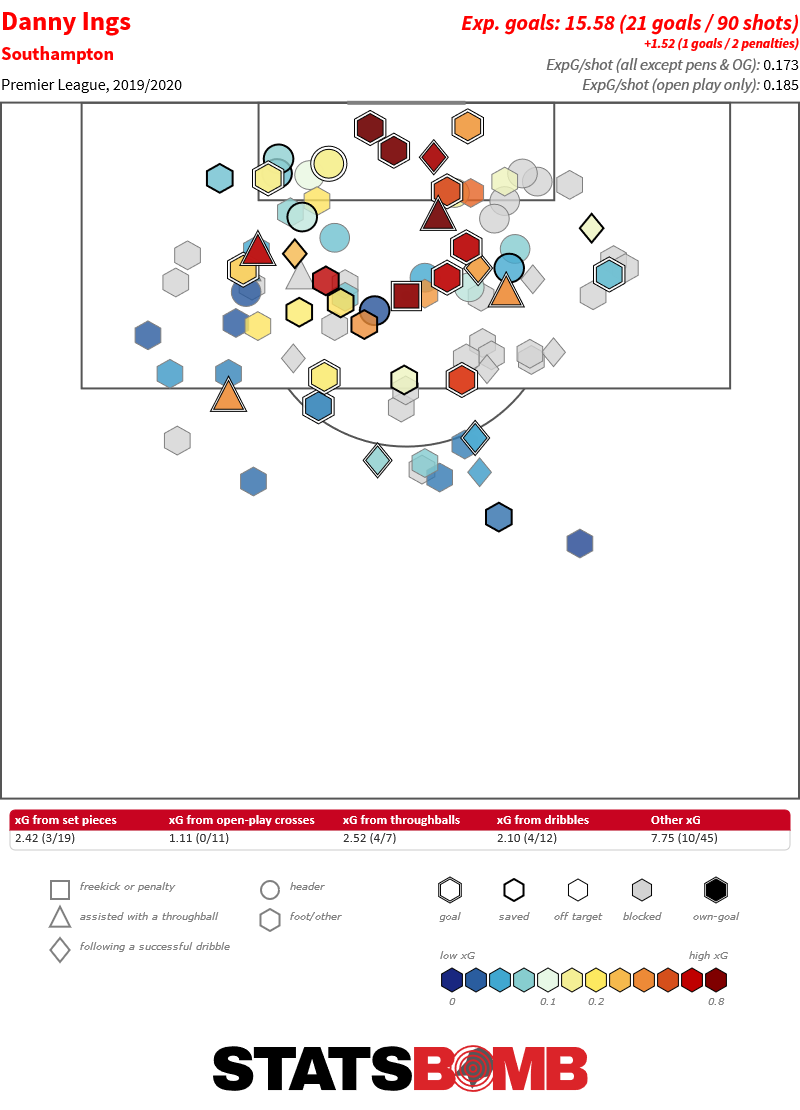 He also led the press: his 25 pressure events per game was highest in the team. Loads of goals, loads of work rate. What’s not to like? He didn’t create much with his passing, but nor did anyone else, that's just not how this team creates. The team pushed high, won the ball back and grabbed shots--they ranked fifth behind the top four sides for shots directly generated from a high press at over three per game. We can see how Southampton have evolved over four seasons here, or at least how Hasenhüttl's tenure has built the press from the front. They're more active high up the pitch than at any time since (to my surprise) Claude Puel in 2016-17, and the pattern in how they play now is very clear:
He also led the press: his 25 pressure events per game was highest in the team. Loads of goals, loads of work rate. What’s not to like? He didn’t create much with his passing, but nor did anyone else, that's just not how this team creates. The team pushed high, won the ball back and grabbed shots--they ranked fifth behind the top four sides for shots directly generated from a high press at over three per game. We can see how Southampton have evolved over four seasons here, or at least how Hasenhüttl's tenure has built the press from the front. They're more active high up the pitch than at any time since (to my surprise) Claude Puel in 2016-17, and the pattern in how they play now is very clear: 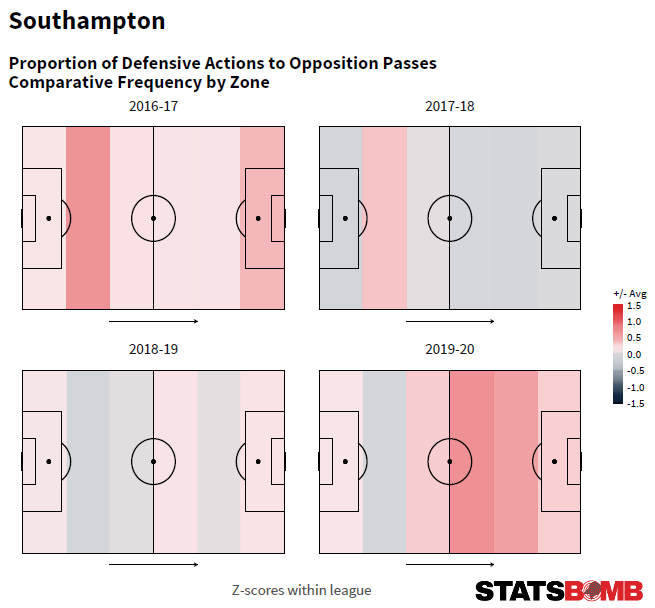 There's a lesson here around lineage and manager recruitment too. It can take time for a manager to get their methods across, even more so if they need to unpick diametrically opposed work done in a different direction by former managers. Having kept faith with Hasenhüttl through a tough period, a concerted and clear style has emerged, with some success. Personnel Southampton have made a couple of early moves in the market to shore up their defence. Kyle Walker-Peters followed up his loan from Tottenham with a permanent move. That a large volume of Tottenham fans were sad to see him depart, feeling he could have been used more over the years is indicative of his general ability. He could easily have been used more in their rotation and should be entirely fine at Southampton, especially with half a season under his belt already. Mohammed Salisu effectively takes Maya Yoshida’s place in the squad and as a young left footed centre back, is a relatively scarce talent within the league, and within this squad. The 6ft3” former Real Valladolid man has just one season of top-flight experience. During that season he was Valladolid’s main back line defender recording significantly higher percentage of defensive clearances than his centre back partners, scarcely being dribbled past but was not error-free, as you might expect from a young centre back. There may be more additions to come. In particular, central midfield looks a little light with Pierre-Emile Højbjerg moving to Tottenham and Harrison Reed and Mario Lemina each landing at Fulham for the forthcoming season at least, instead of returning. There's also some hope to see better in season two from Che Adams and Moussa Djenepo. Both found it hard to gain consistent minutes in 2019-20, but some starts late on saw Adams finally score his first Premier League goal with a kooky 40-yarder against Manchester City and he followed it up with three more before season's end. Meanwhile, Djenepo had a stop-start season with injuries, the loss of his mother and suspension all contributing to reduced time spent on the pitch. when he did play, he showed he wasn't far off the player he showed at Standard Liege:
There's a lesson here around lineage and manager recruitment too. It can take time for a manager to get their methods across, even more so if they need to unpick diametrically opposed work done in a different direction by former managers. Having kept faith with Hasenhüttl through a tough period, a concerted and clear style has emerged, with some success. Personnel Southampton have made a couple of early moves in the market to shore up their defence. Kyle Walker-Peters followed up his loan from Tottenham with a permanent move. That a large volume of Tottenham fans were sad to see him depart, feeling he could have been used more over the years is indicative of his general ability. He could easily have been used more in their rotation and should be entirely fine at Southampton, especially with half a season under his belt already. Mohammed Salisu effectively takes Maya Yoshida’s place in the squad and as a young left footed centre back, is a relatively scarce talent within the league, and within this squad. The 6ft3” former Real Valladolid man has just one season of top-flight experience. During that season he was Valladolid’s main back line defender recording significantly higher percentage of defensive clearances than his centre back partners, scarcely being dribbled past but was not error-free, as you might expect from a young centre back. There may be more additions to come. In particular, central midfield looks a little light with Pierre-Emile Højbjerg moving to Tottenham and Harrison Reed and Mario Lemina each landing at Fulham for the forthcoming season at least, instead of returning. There's also some hope to see better in season two from Che Adams and Moussa Djenepo. Both found it hard to gain consistent minutes in 2019-20, but some starts late on saw Adams finally score his first Premier League goal with a kooky 40-yarder against Manchester City and he followed it up with three more before season's end. Meanwhile, Djenepo had a stop-start season with injuries, the loss of his mother and suspension all contributing to reduced time spent on the pitch. when he did play, he showed he wasn't far off the player he showed at Standard Liege: 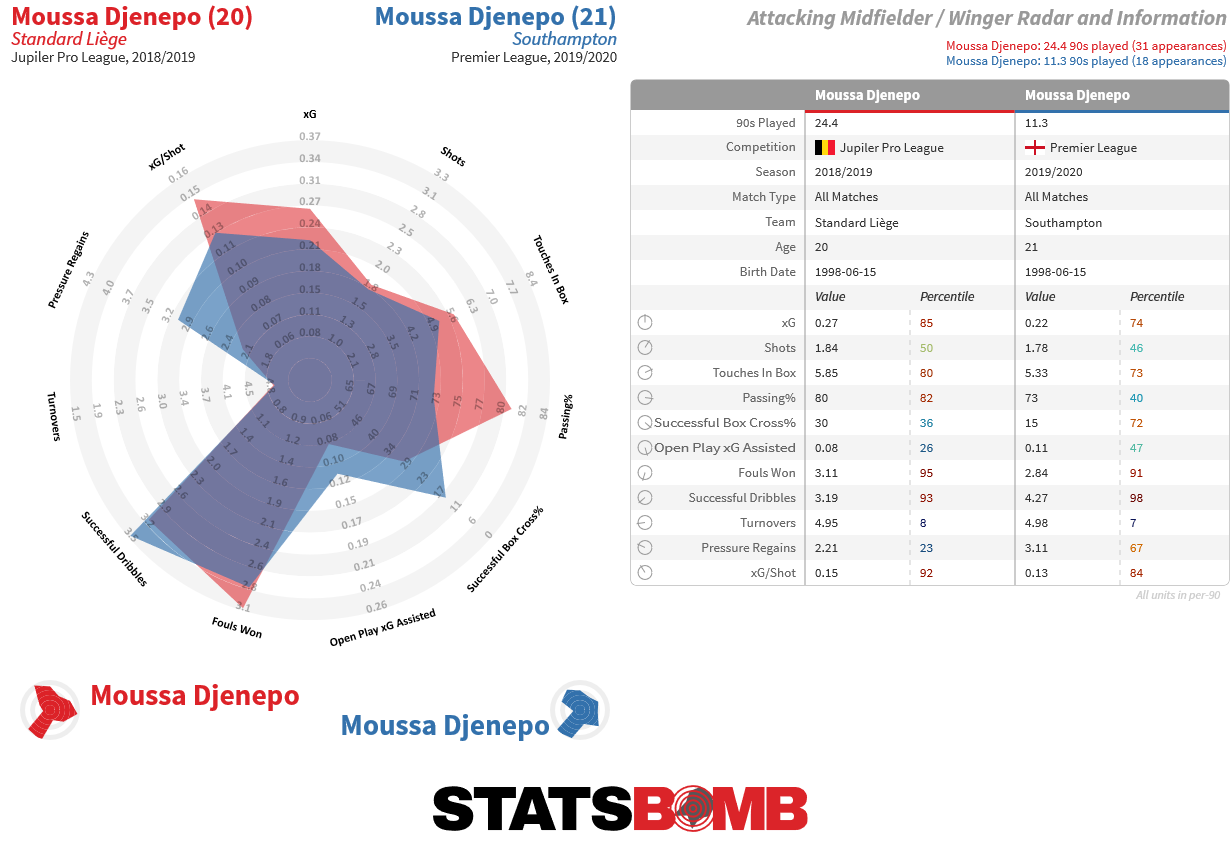 Projection Southampton finished eleventh last season, which represented getting the car back on the tarmac after a couple of seasons of off-roading down the table. All in, raw expected goals rated them eighth best and liked them more than Tottenham and Arsenal. Sporting Index opening lines had them at around 50 points which maroons them in mid-table but would also be completely safe. You don't look at this squad and see the appealing talent levels that led Liverpool to routinely buy Southampton players for so many years, and ironically the one player who made the opposite journey, Ings, is one that will likely have a huge bearing on how Southampton progress this season. If he can stay fit and continue to score at a good clip, it takes the pressure off the midfield, which has been somewhat goalshy for a number of seasons. It is also good for the league that we have a non-elite pressing team competing at a solid level, and Hasenhüttl may not have hit his ceiling here yet. Anything in the top half will represent another good season, and should certainly be the aim.
Projection Southampton finished eleventh last season, which represented getting the car back on the tarmac after a couple of seasons of off-roading down the table. All in, raw expected goals rated them eighth best and liked them more than Tottenham and Arsenal. Sporting Index opening lines had them at around 50 points which maroons them in mid-table but would also be completely safe. You don't look at this squad and see the appealing talent levels that led Liverpool to routinely buy Southampton players for so many years, and ironically the one player who made the opposite journey, Ings, is one that will likely have a huge bearing on how Southampton progress this season. If he can stay fit and continue to score at a good clip, it takes the pressure off the midfield, which has been somewhat goalshy for a number of seasons. It is also good for the league that we have a non-elite pressing team competing at a solid level, and Hasenhüttl may not have hit his ceiling here yet. Anything in the top half will represent another good season, and should certainly be the aim.
If you're a club, media or gambling entity and want to know more about what StatsBomb can do for you, please contact us at Sales@StatsBomb.com We also provide education in this area, so if this taste of football analytics sparked interest, check out our Introduction to Football Analytics course Follow us on twitter in English and Spanish and also on LinkedIn
